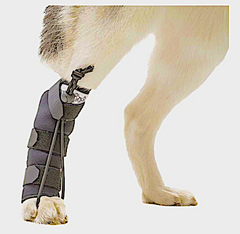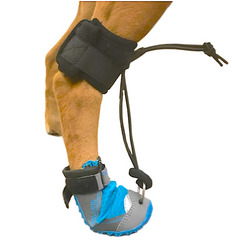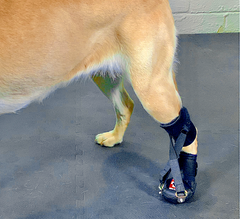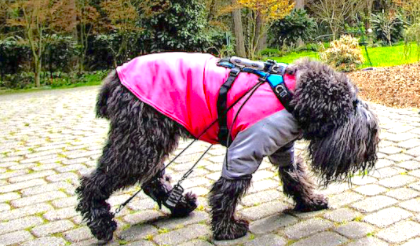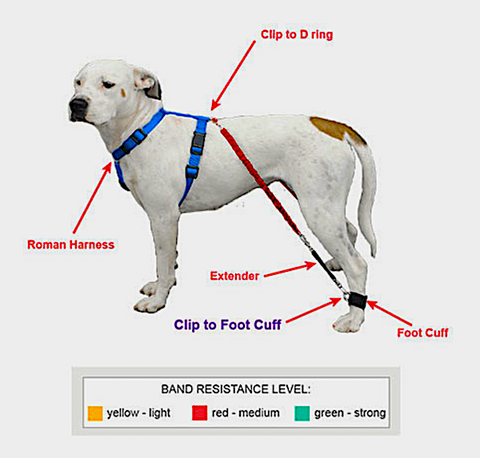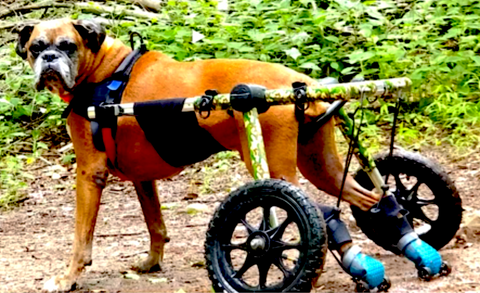
Vital Vet’s Product Wizard did the research and sourced the best protection and anti-dragging gadgets for hind paws. Here’s what they have to say and their picks.
There are many conditions that can cause a dog to knuckle or drag their back paws. Some of these include degenerative myelopathy (DM), sciatic nerve injury, disc disease, spinal cord injury, cancer, and fibrocartilaginous embolism (FCE, stroke). Painful arthritis can also cause a dog to scrape or drag their paws.
Regardless of the condition, remember to consider the following when choosing a gadget or device to help your dog walk better:
- Make sure the device is lightweight – Your dog is already having mobility issues. Even using a protective boot over the scraped paw of a weak dog can be too heavy; the added weight may cause the dog to knuckle or drag even more.
- The device should be assistive – This means that it helps your dog place the paw correctly on the ground or helps bring their leg forward if it’s dragging behind.
- Choose a device that provides the right amount of help – If your dog only scuffs a little, use something that gives a little help placing the paw or protecting the nails from being worn down. Remember that dogs need to keep their strength up. Using a device that does most of the work for them doesn’t let them exercise like they should.
- Make sure the device fits well and is intended for the planned activity. If the boot does not fit snuggly, it will come off or worse, can cause the dog to trip or fall. If your dog is still quite active (e.g., goes on hikes, swims), the device should be very durable, protect the paws, and be ok to use in the water.
- Most gadgets should be removed after taking your dog for a walk. Some devices can be worn for longer but check the manufacturer’s recommendations. All devices should be removed at night when the dog is sleeping. Choose a device that you are able to apply and remove easily.
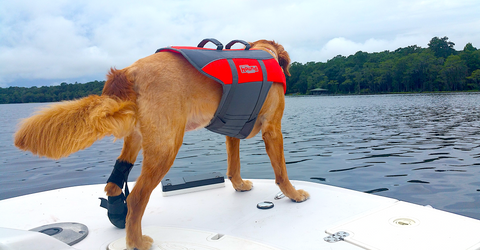 this dog continues his active lifestyle with a left Hindlimb Dorsi-Flex Assist
this dog continues his active lifestyle with a left Hindlimb Dorsi-Flex Assist
OTHER THINGS TO KNOW WHEN CHOOSING AN ANTI-DRAGGING DEVICE
Toy breeds and cats – If you have a little tyke, you’ll probably need something that’s custom-made since most anti-dragging gadgets are too heavy or big for tiny pets. Thera-Paw makes custom anti-knuckling/dragging devices for all size pets, including the little ones. Their record to date for the smallest gadget is an anti-dragging aid for a pet guinea pig!
Short legs – If your dog has short legs and is dragging, the most helpful device is either one that does not include a boot (one that anchors around the toes or ankle) or one that helps to pull the whole hind leg forward. Dogs with weak and short legs can’t pick them up high enough to move well across the ground, and a boot will make this even harder for them (not enough ground clearance). Also, the elastic toe straps are too short from boot to ankle cuff to do an effective job of pulling the toes up [the lever arm (paw-to-ankle length) is short and therefore requires a lot more force to move (pick up toes)].
Straight hocks/ankles – If you have a dog with very straight hocks/ankles, you will need either a one-piece unit or a device that pulls the whole leg forward. Any device that has a separate cuff that fastens above the hock will not work for a straight-legged dog because the cuff will fall down the leg when the toe straps apply tension on it (see diagram below).
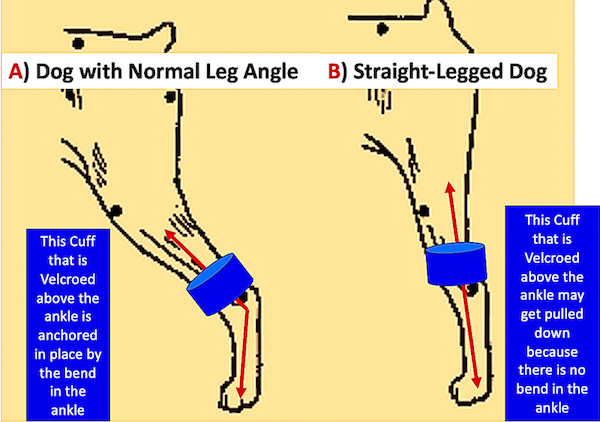
Pets with very recent nerve injuries – If your pet is knuckling or dragging because of a recent (less than 2-3 weeks) injury (e.g., hit by car, recent surgery that can temporarily injure a nerve), they may go through many changes as they start to heal. If the leg does not have any function, consider using a hard splint so that the leg is held immobile and can at least be used to stand and balance. If your pet is regaining movement quickly, then they might just need a protective sock or light boot to keep the paw safe and free from scrapes. As time goes on, different devices might be useful to assist your pet through their various stages of recovery so it’s helpful to know what’s available.
VITAL VET’S PRODUCT WIZARD RECOMMENDATIONS
These 3 devices help pull the toes up
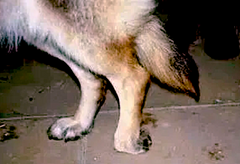
The above picture is what a dog looks like that can benefit from the 3 devices listed below. The dog stands relatively normally except that they sometimes stands on their knuckles and sometimes drag their paw a little behind.
This device is ultralight and the paw is not covered so dogs can “feel” the ground when they walk and the paw can breathe (dogs sweat through their paws, and keeping paws covered for a long time can lead to overheating and irritation).
- This is a one-piece unit and useful for dogs with straight hocks.
- For dogs that need a little-to-moderate help picking up their toes.
- Good for short-term use (use only for a few minutes at a time).
- Dogs should be strong enough to flex their knee and bring their hip/leg forward on their own.
This device has a boot component to help protect the toes and nails.
- For dogs that need moderate help picking up their toes and flexing their ankle.
- This device can be left on for up to a few hours at a time.
- Good for longer walks or longer use and to help protect the paw.
- Dogs should be strong enough to flex their knee and bring their hip/leg forward on their own.
This device also has a protective and padded boot for injured paws. It uses 2 sets of heavy-duty elastic straps that apply extra force to help pull the toes up and flex the ankle.
- For dogs that need more help picking up their toes and flexing their ankle. This is a good choice for dogs that are knuckling more than 50% of the time when walking.
- This device can be left on for up to a few hours at a time.
- Good device to use if taking your dog on longer walks and to help protect the paw.
- Dogs should be strong enough to flex their knee and bring their hip/leg forward on their own.
- Custom-made versions are available.
These 2 devices help pull the entire leg forward
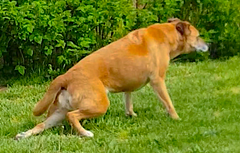
For dogs that are dragging their back legs and paws, these devices are great because they help to pull the whole leg forward. These may be good options for dogs that need more help but are not yet ready for a wheelchair.
1) Canine Mobility Anti-Knuckling Device
This device is useful for dogs that are struggling a bit more and who have weakness throughout their hind legs (including knees and hips). There are no boots so the paws remain uncovered and the dog can feel the ground. Nylon straps are applied in a figure “8” fashion around the toes and ankle to keep the toes up, and a bungee is attached from the ankle to a chest harness to move the leg.
- Great for weaker dogs that are struggling with moving their hind legs but are not ready for a wheelchair (e.g., dogs with degenerative myelopathy, disc disease).
- Can be used for both legs but also just for one leg, for example in a dog with sciatic nerve injury, arthritis in one leg, or cancer in the leg that causes weakness.
- You will need to use a harness with this device so that the elastic straps can fasten to it. It is recommended that you use a Help ‘Em Up Harness or similar, and the harness is sold separately on the website. Here is an alternative harness, but any harness with d-ring will do.
- This device should only be worn for short walks then removed.
2) Biko Progressive Resistance Bands
This device is useful for dogs that have trouble bringing both hind legs forward – dogs with weakness throughout the hind legs. There are no boots; instead, ankle cuffs are fastened just above the paws. Elastic bands are clipped onto the ankle cuffs then to a harness.
- This comes with 3 sets of elastic bands that attach from the ankle cuff to harness. The elastic bands have different degrees of tension (stiffness); if your dog drags a little, the lighter bands are used but if your dog drags a lot, the stiffer bands are used.
- The elastic bands attach to the D-ring of a harness, which is not included. You will need to supply your own harness.
- You may need to get some protective boots for your dog since there is no mechanism in this device to help lift the toes up.
This device is great for dogs in wheelchairs with back leg paralysis
You might want to try these skates for dogs that can still move their back legs a little in their wheelchairs or those that continue to drag their toes while in their cart. Tiny wheels are attached to the toe end of the boots so that the paws can roll and glide easily over most surfaces.
- Dogs can use these skates with or without wheelchair stirrups.
- Good alternative if you find yourself having to constantly replace your dog’s boots because they continue to drag while in their wheelchairs.
SCOOTING AROUND WHEN INSIDE
Since some devices should be removed when indoors or when your dog is done exercising, what can be done to protect your dog’s paws when not wearing their device? Socks or lightweight boots can help keep paws protected as your dog scoots or shuffles around while indoors. These are our recommendations for socks and boots for paw protection. Also, check out this article for solutions to help your pet have traction, stay safe, and be more mobile inside the home.
WAYS TO EXTEND THE LIFE OF YOUR DEVICE
Some devices listed above can be expensive. Also, dogs that are weak can continue to scuff their paws a little even when wearing an anti-dragging device. There are some easy and inexpensive ways to extend the wear life of your pet’s device and it’s wise to do this well before the device starts to break down or get a hole.
For devices that include a boot, the sole of the boot can get worn down. Before you discover a hole, here are some quick fixes:
- Cover the bottom of the boot sole with outdoor, all-weather duct tape. Duct tape is really light so there’s no added weight. It sticks well, is inexpensive, and can be layered and replaced as needed.
- For more heavy-duty sole patching and protection, liquid rubber products can be applied and layered. These products are smeared on then harden into rubber. Once a layer dries, you can add another layer on top, and so on. This produces rugged protection and also helps to build a paw lift should your dog have a slightly shorter leg [e.g., dogs that have undergone a femoral head ostectomy (FHO) can sometimes have a shorter leg after the procedure].
Boot cuffs can be kept clean and protected by lining the cuff with self-adhesive foam padding. This padding can also be used to help protect your dog’s paw from rubs. Always remember to apply the padding to the boot or cuff area and not directly on your dog’s skin.
If your dog uses a device with a boot, we recommend also using anti-chaffing and moisture-absorbing powder. Sprinkle the powder inside the boot or rub some on the skin around the ankle before applying the cuff. The powder will help protect the skin. Do not apply powder over an open wound.
Many anti-dragging devices have Velcro straps that can get damaged. It’s not a bad idea to get a few hook and loop fastening straps in case a strap breaks.
FINAL NOTES
Regardless of what device you choose, we always recommend helping your dog move around safely by using a supportive harness or wide-based and padded sling. For dogs that need to wear a harness all day, we like this padded, walking harness. The Help ‘Em Up Harness is terrific for bigger dogs that need a lot of help.
Keeping your dog safe and mobile takes a little effort but can go a long way toward improving their mobility and independence. The easier you can make life for your dog the easier life will be on you.
If you want recommendations for a product or device for a pet with special needs, contact Vital Vet’s Product Wizard.
A Vital Vet Publication
Let’s work together and give them the best life possible!
contains affiliate and/or partner links–read


